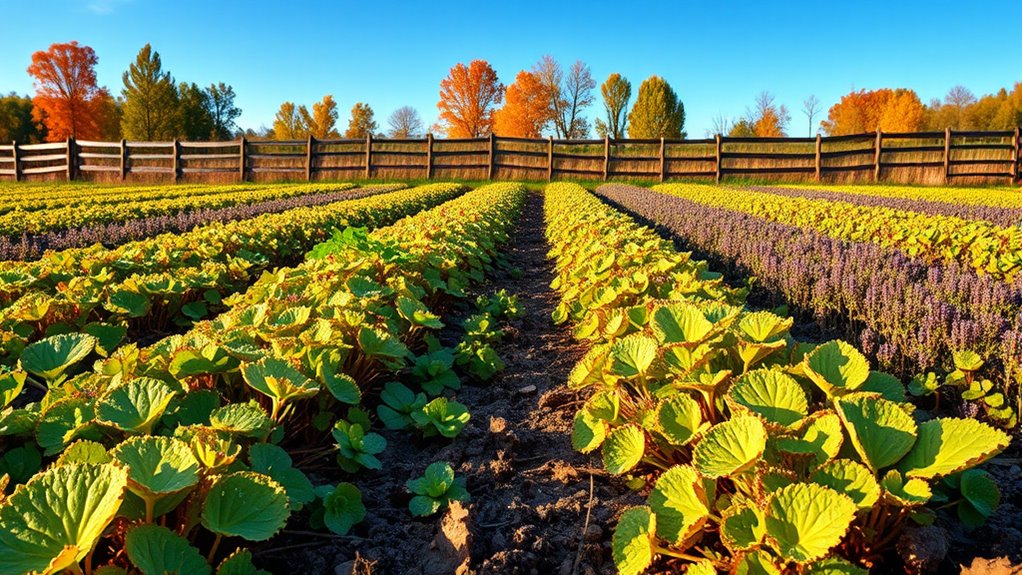A beginner’s guide to fall cover crops helps you understand how they improve soil health, prevent erosion, and suppress weeds, all while fixing nitrogen naturally if you choose legumes. To start, pick the right crop based on your goals and plant 4-6 weeks before the first frost, ensuring proper soil prep. Managing and terminating your cover crops properly maximizes benefits. Keep exploring for tips on selecting, planting, and maintaining cover crops to create a thriving garden or farm.
Key Takeaways
- Understand the benefits of fall cover crops, such as improving soil fertility, preventing erosion, and suppressing weeds.
- Choose suitable cover crops like legumes for nitrogen fixation or grasses for erosion control, based on your goals.
- Plant 4-6 weeks before the first frost, ensuring soil conditions are optimal for germination.
- Properly manage and terminate cover crops before seed set to maximize soil health and prevent unwanted self-seeding.
- Incorporate cover crops into your rotation plan to enhance soil quality and support sustainable gardening practices.
Understanding the Purpose of Fall Cover Crops
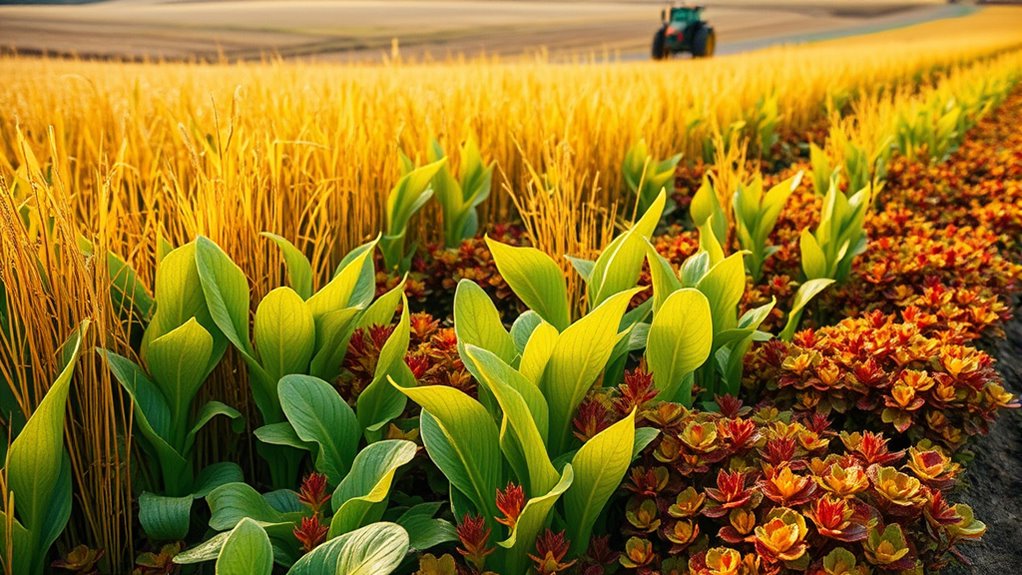
Understanding the purpose of fall cover crops is essential for maximizing your garden’s health and productivity. These crops improve soil fertility by adding organic matter and nutrients, which benefit your future planting seasons. They also help prevent soil erosion and suppress weeds, keeping your garden beds in good shape. Additionally, cover crops play a crucial role in pest management by disrupting pest cycles and providing habitat for beneficial insects. When you plant cover crops in the fall, you’re not only protecting the soil but actively supporting the overall health of your garden ecosystem. Incorporating cover crops enhances soil health and promotes sustainable gardening practices. By understanding these benefits, you can choose the right cover crops to enhance soil quality and reduce pest pressures, setting a strong foundation for a thriving garden next season. Using cover crop benefits as a guide can help you select the most suitable types for your specific garden needs. Proper planning and selection can also contribute to integrated pest management, further supporting a healthy garden environment. Additionally, selecting appropriate cover crops can improve soil structure and water retention, leading to more resilient soil over time.
Choosing the Right Cover Crop for Your Goals
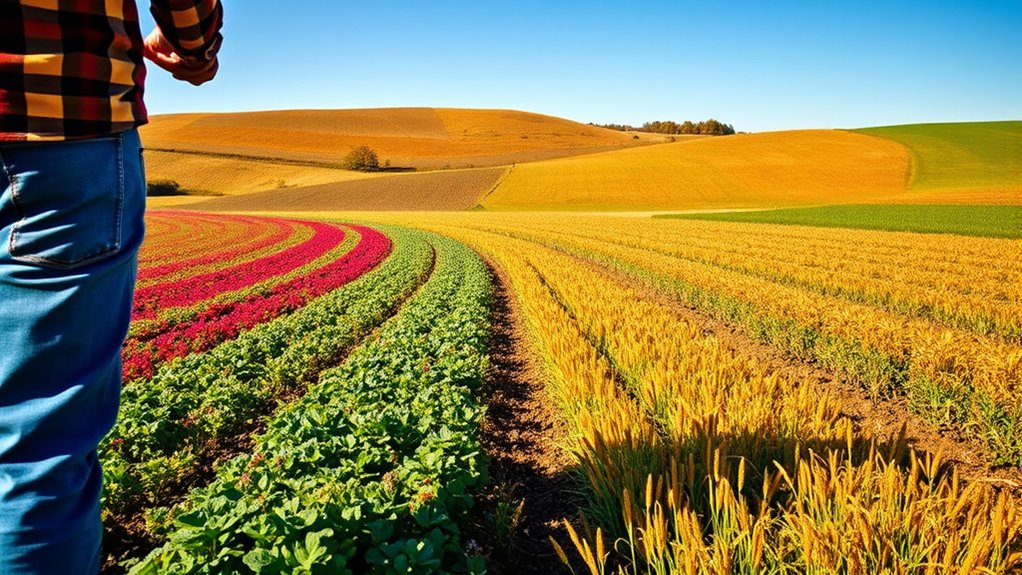
Choosing the right cover crop depends on your specific goals for the garden, whether that’s improving soil fertility, controlling weeds, or managing pests. To enhance soil health and support effective crop rotation, select cover crops tailored to your needs. Consider these options:
- Legumes like clover or vetch to fix nitrogen, boosting soil fertility.
- Grasses such as rye or oats to prevent erosion and suppress weeds.
- Brassicas like radish or mustards to break up compacted soil and manage pests.
- Incorporating cover crop benefits into your planning can further optimize your garden’s productivity and sustainability. Using the appropriate cover crop can also help soil health and create a resilient garden ecosystem. Additionally, selecting cover crops aligned with market growth projections can support sustainable practices. Research shows that selecting the proper cover crop influences overall crop rotation strategies, contributing to long-term garden success. Matching your goals with the crop’s characteristics ensures you get the most benefit from your cover crop. Think about how each option influences soil health and how it fits into your crop rotation schedule. The right choice helps create a sustainable, productive garden year-round.
Popular Cover Crop Options for Autumn Planting
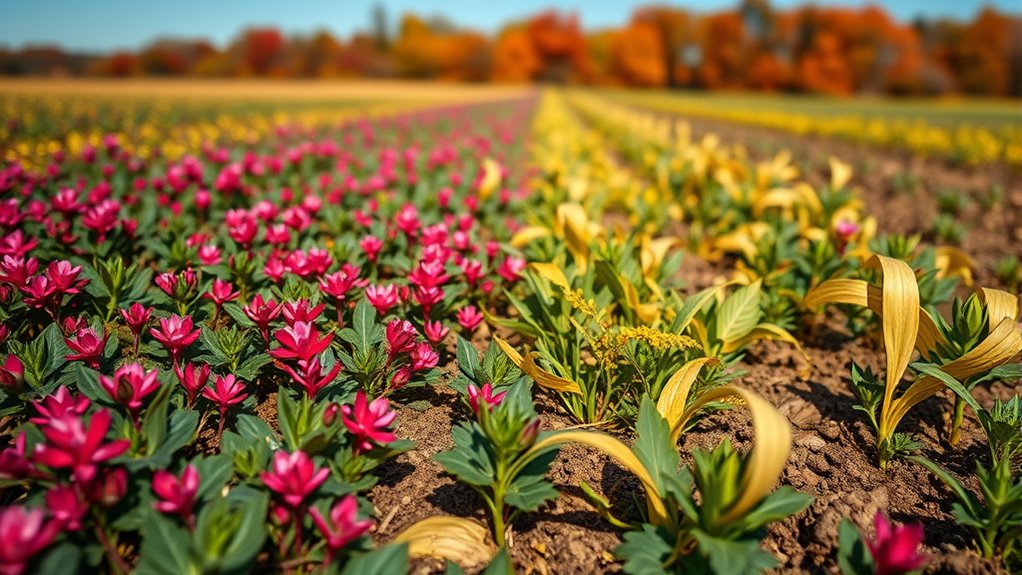
Autumn is an ideal time to plant cover crops that prepare your soil for the next planting season. Popular cover crop options for autumn planting include rye, crimson clover, vetch, and hairy vetch. Rye is a hardy grain that quickly adds organic matter and prevents erosion, making it a favorite among gardeners. Crimson clover and vetch are legumes that fix nitrogen, enriching your soil naturally. These cover crop varieties fit well into autumn planting schedules because they establish quickly and tolerate cooler temperatures. Incorporating these options into your fall planting plan boosts soil health and reduces weeds. Selecting the right cover crops depends on your soil needs and climate, but these options are reliable choices for a successful fall cover crop. Additionally, understanding the benefits of cultural intelligence can help you adapt your gardening strategies to local cultural practices and environmental conditions for optimal results. Recognizing the importance of soil health maintenance can further enhance your overall gardening success. For example, choosing cover crops that are suited to your specific climate conditions can ensure better germination and growth throughout fall. Moreover, paying attention to soil amendments can improve the establishment and effectiveness of your cover crops, especially in depleted soils. Staying informed about evolving agricultural practices can also help you select the most sustainable options for your garden.
Timing and Planting Techniques
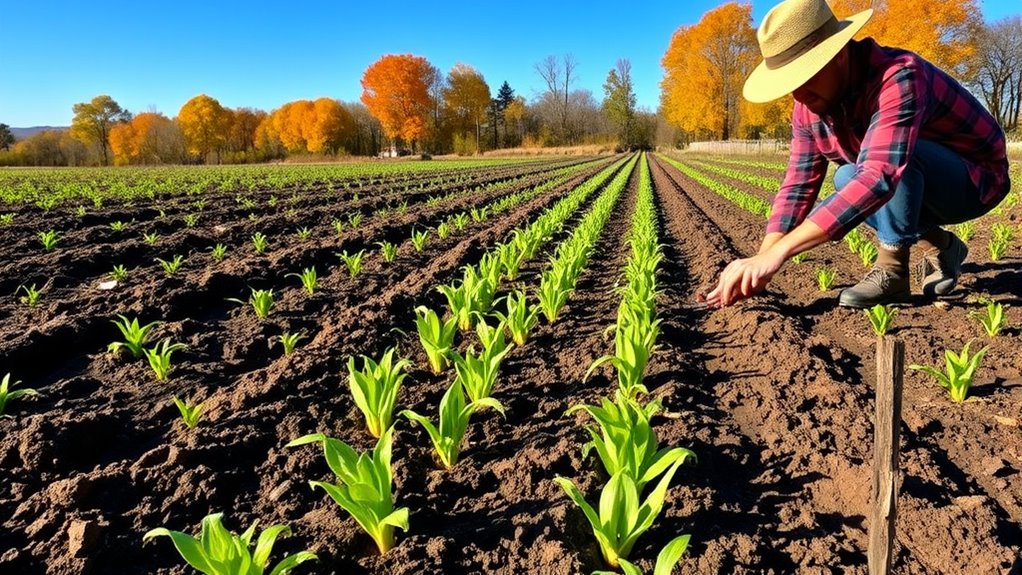
Timing is essential when planting fall cover crops to guarantee they establish well before winter sets in. To do this, you should focus on your seed selection and adhere to appropriate planting schedules. Here are key steps to follow:
- Choose the right seed based on your climate and goals, such as oats for quick cover or clover for nitrogen fixation.
- Check local planting schedules to determine the best time, generally 4-6 weeks before the first expected frost.
- Plant when soil temperatures are still warm enough to promote germination, usually late summer to early fall. Understanding optimal planting conditions can further improve germination success.
- Strategic timing can also influence the growth rate of your cover crops, ensuring they mature in time for winter.
- Additionally, ensuring your planting site complies with local zoning regulations can help avoid legal issues and facilitate smoother planting procedures.
- Being aware of climate considerations can help you select the most suitable cover crops for your region and ensure successful establishment.
Preparing Your Soil Before Planting
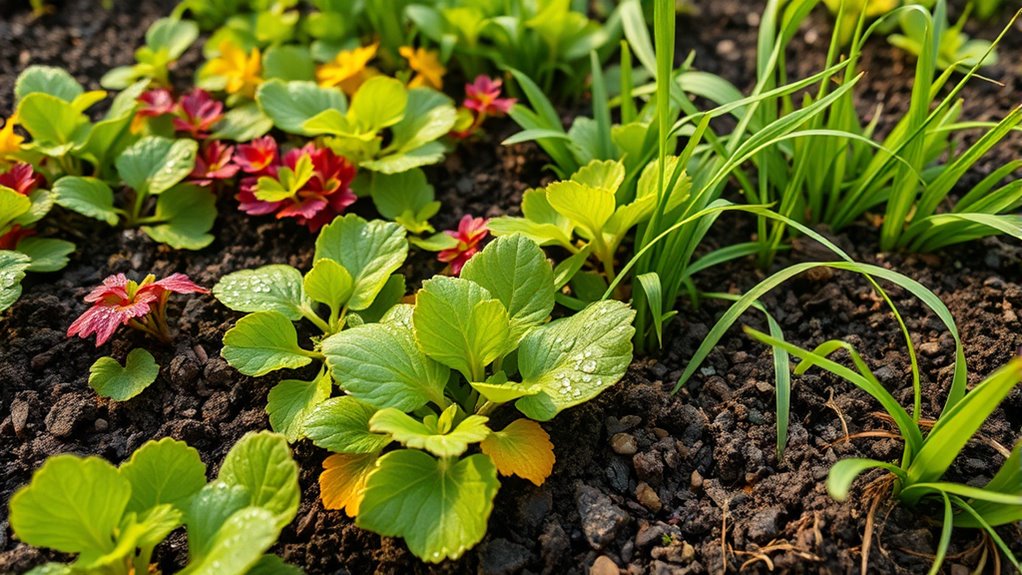
Before planting your fall cover crops, it’s important to prepare your soil to guarantee ideal germination and growth. Begin with soil testing to determine its pH and nutrient levels, helping you identify any deficiencies or imbalances. Based on the results, you can amend your soil accordingly. Incorporate compost application to improve soil fertility, enhance structure, and promote healthy root development. Spread a layer of compost evenly over the soil surface and work it in lightly if needed. Proper soil preparation ensures your cover crops establish quickly and grow vigorously, maximizing their benefits like nitrogen fixation and erosion control. Taking these steps now will set a strong foundation for a successful cover crop season. Engaging in soil testing allows you to understand your soil’s specific needs and tailor amendments effectively. Additionally, considering the power of different fertilizers can further optimize soil health and productivity. Utilizing diversification strategies in your soil amendments can also help improve overall soil resilience and microbial activity.
Managing and Maintaining Cover Crops
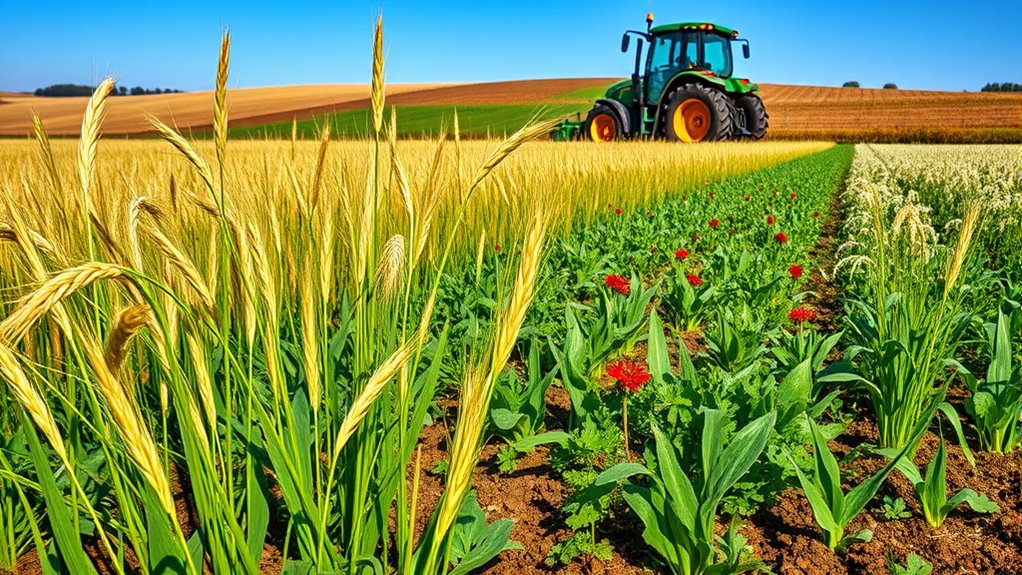
To effectively manage your cover crops, it’s essential to monitor their growth regularly and address any issues promptly. Keep an eye out for cover crop pests that can weaken plants or spread disease. To maintain healthy cover crops, consider these steps:
- Inspect for pests and treat infestations early to prevent widespread damage.
- Promote cover crop seed diversity to encourage a resilient ecosystem that can naturally suppress pests.
- Adjust watering and nutrient levels as needed to support vigorous growth and prevent weeds.
- Utilize air quality monitoring techniques to identify environmental factors that may affect crop health.
- Regularly review and adapt your management practices based on knowledge of ecological interactions to optimize cover crop performance.
- Incorporating essential oils in pest management strategies can also be beneficial for natural pest control. Additionally, understanding the trustworthiness of seed suppliers can help ensure the quality and authenticity of your cover crop seeds.
Consistent monitoring helps identify problems before they escalate. Managing pests effectively and fostering seed diversity are key to a thriving cover crop. Proper maintenance ensures your cover crops provide maximum benefits for soil health and future planting success.
Terminating Cover Crops Effectively
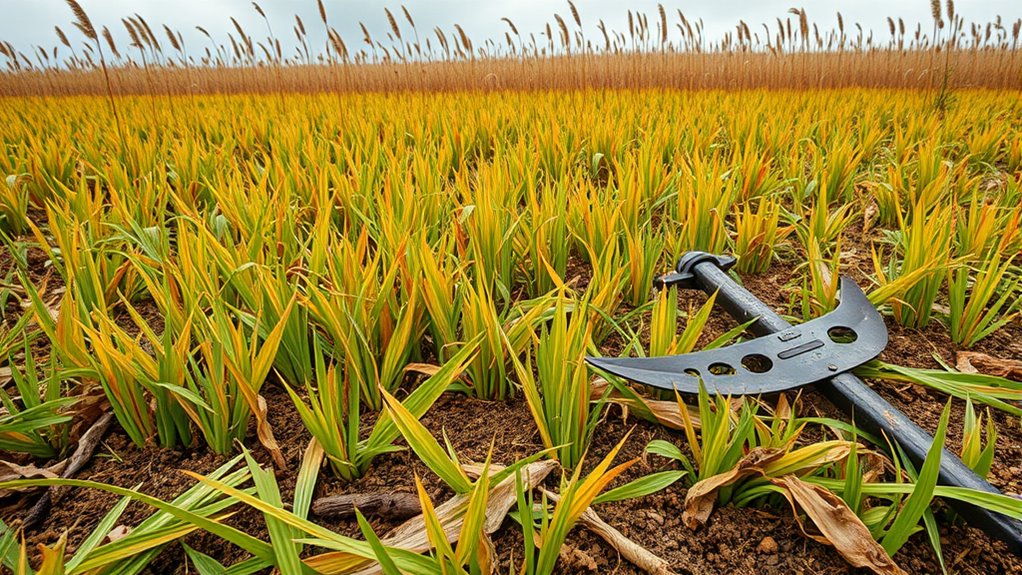
Timing is key when ending your cover crop, so you want to choose the right moment to terminate it before planting your next crop. You can kill it through methods like mowing, tilling, or applying herbicides, depending on your goals and equipment. After termination, prepare the soil properly to make sure it’s ready for planting and to maximize nutrient benefits.
Timing for Termination
Knowing the right moment to terminate your cover crop is crucial for maximizing its benefits and ensuring a smooth shift to the next planting phase. Timing depends on the cover crop varieties you choose and their growth stage. Ideally, you should consider these key points:
- Growth Stage: Terminate before the cover crop produces seeds to prevent self-seeding and control cover crop pests.
- Weather Conditions: Aim for termination when conditions are dry to reduce disease risk and ease removal.
- Soil Health Goals: Finish before planting your main crop, allowing ample time for soil to absorb nutrients and minimize pest issues.
Methods of Termination
Choosing the right method to terminate your cover crop is essential for effective soil management and preparing for the next planting. You can use mulching methods, chemical treatments, or a combination of both. Mulching involves applying organic materials like straw or compost to suppress weeds and decompose naturally. Chemical treatments, such as herbicides, quickly kill cover crops but require careful application to avoid soil contamination. Here’s a quick comparison:
| Method | Pros | Cons |
|---|---|---|
| Mulching Methods | Improves soil health | Takes longer to kill crop |
| Chemical Treatments | Fast and effective | Potential environmental impact |
| Mechanical Removal | Complete removal | Labor-intensive |
| Solarization | Non-chemical, eco-friendly | Needs sunny conditions |
| Grazing | Natural, sustainable | Limited by livestock access |
Choose based on your timing, resources, and environmental considerations.
Soil Preparation Post-Cover
After successfully terminating your cover crop, it’s essential to prepare the soil properly to guarantee a smooth shift to your next planting. Start by conducting a soil testing to assess nutrient levels and identify deficiencies. Next, focus on nutrient balancing by amending the soil with necessary fertilizers or organic matter to optimize growth conditions. Finally, till or lightly incorporate the cover crop residue to improve soil aeration and facilitate nutrient release. This process helps break down organic matter and releases nutrients for future crops. Proper soil preparation ensures your soil is in ideal condition, promotes healthy root development, and reduces the risk of diseases. Taking these steps guarantees your next planting will thrive on a well-prepared, nutrient-rich foundation.
Benefits of Using Cover Crops in Your Garden or Farm
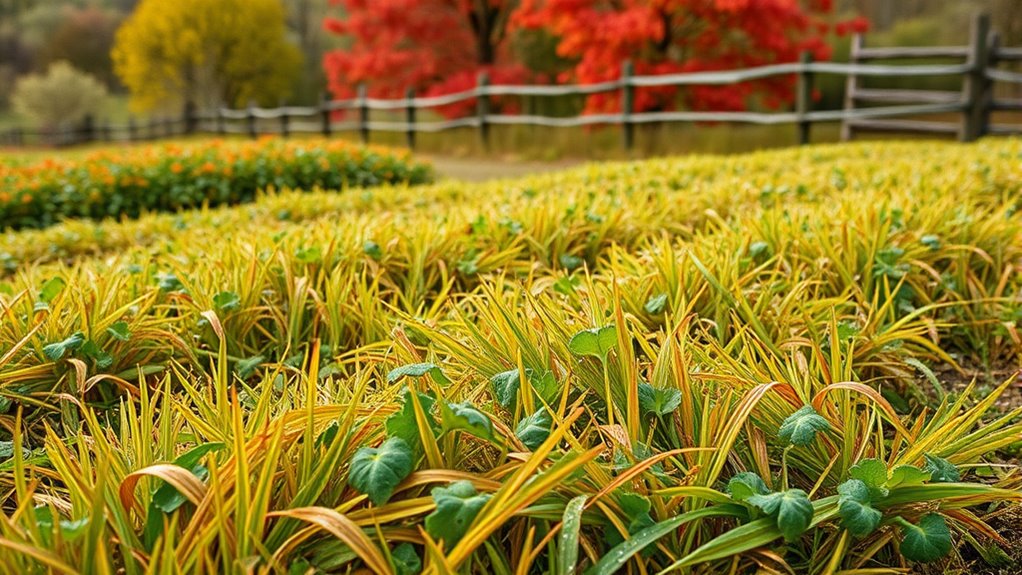
Using cover crops offers numerous benefits for your garden or farm, making them a valuable addition to your planting routines. Different cover crop varieties, such as legumes, grasses, and brassicas, provide specific cover crop benefits that improve soil health and productivity. They help fix nitrogen, reducing the need for synthetic fertilizers, and prevent soil erosion by protecting the surface. Cover crops also enhance soil structure, increase organic matter, and suppress weeds naturally. Additionally, they attract beneficial insects and pollinators, supporting overall ecosystem health. Incorporating cover crops into your fall planting schedule can lead to richer soil, better crop yields, and a more sustainable garden or farm operation. Their versatility makes them a smart, eco-friendly choice for any gardener or farmer.
Tips for Incorporating Cover Crops Into Your Annual Planning
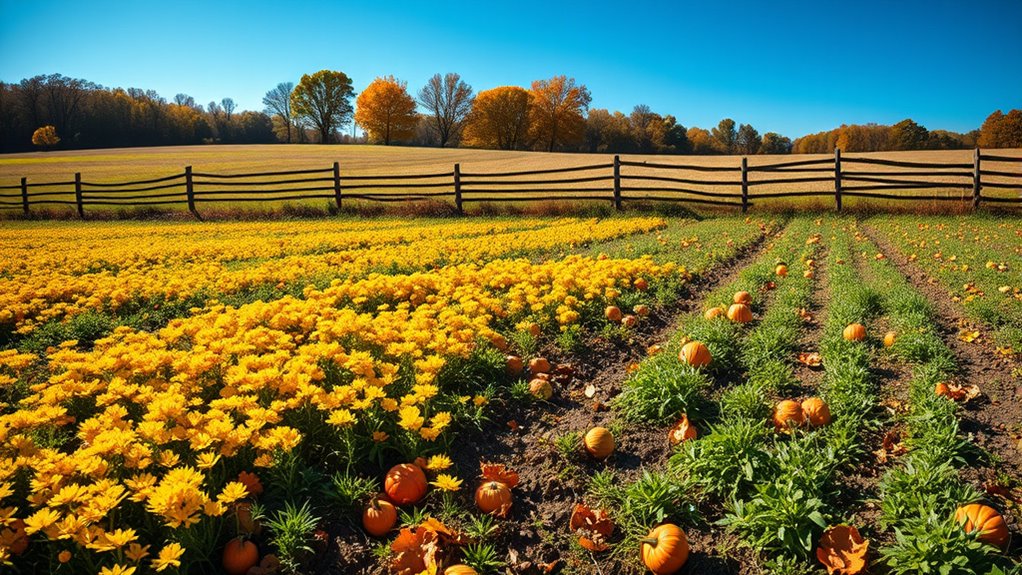
Integrating cover crops into your annual planning requires a strategic approach to maximize their benefits. First, consider your goals, such as soil health or weed suppression, to select the right cover crop. Next, research cover crop seed suppliers to find reliable sources with competitive cover crop pricing. Finally, plan planting and termination dates to fit your crop rotation schedule and local climate. Keep these tips in mind:
Strategically plan cover crop timing and suppliers to maximize benefits and fit your farm schedule.
- Align cover crop planting with your overall farm calendar.
- Compare cover crop seed suppliers for quality and cost.
- Adjust your planning based on seasonal weather patterns and soil needs.
Frequently Asked Questions
Can Cover Crops Be Used in Small Garden Beds?
Yes, you can definitely use cover crops in small garden beds. They help improve soil health, suppress weeds, and attract beneficial insects. You should consider companion planting and crop diversity when choosing cover crops, as mixing different types can maximize benefits. Even in small spaces, cover crops can make a big difference by enriching your soil and supporting a healthy, productive garden. Just guarantee you select the right types for your specific needs.
How Do Cover Crops Affect Soil Ph Levels?
Like a gentle hand stabilizing a spinning top, cover crops influence soil chemistry and pH adjustment. They can either raise or lower soil pH depending on the type you choose, helping create a balanced environment for your plants. Leguminous cover crops add nitrogen, slightly increasing pH, while others like rye can lower acidity. Your choice of cover crop directly impacts soil pH levels, making your soil healthier and more productive.
Are There Any Pests Associated With Fall Cover Crops?
You might wonder if fall cover crops attract pests. While some cover crops can draw insects, proper pest management minimizes issues. Certain plants may attract beneficial insects, aiding pest control, but others could bring unwanted pests. Regular monitoring helps you identify insect attraction early, allowing you to take targeted action. By choosing the right cover crops and maintaining good practices, you can reduce pest problems and keep your soil healthy.
How Long Do Cover Crops Need to Grow Before Termination?
Time flies when you’re waiting for a cover crop to grow, but patience is essential. Typically, you want a cover crop duration of about 4 to 8 weeks, depending on the type and your goals. During this growth period, the plants develop enough to protect and enrich your soil. Keep an eye on their development, and don’t cut corners—proper growth ensures the best benefits when you terminate and incorporate them.
Can Cover Crops Be Integrated With Existing Crop Rotations?
You can definitely integrate cover crops with your existing crop rotations, enhancing rotational benefits and soil health. By choosing crop-compatible cover crops, you guarantee they won’t compete with main crops or disrupt harvest schedules. Proper planning allows you to maximize benefits like nutrient fixing and weed suppression while maintaining productivity. Incorporating cover crops strategically supports sustainable farming practices and improves overall soil fertility, making your rotation more resilient and productive.
Conclusion
By choosing the right cover crops and timing your planting, you can improve your soil health and boost your garden’s productivity. Are you ready to make cover crops a key part of your fall gardening routine? With simple steps and thoughtful planning, you’ll enjoy richer soil and better yields. So why wait? Start exploring your options today and watch your garden thrive through every season.
Susannah expertise lies in researching and compiling evidence-based content on juicing, nutrition, and overall health. She is committed to ensuring that The Juicery World offers accurate, up-to-date, and trustworthy information to empower readers to take control of their health. Susannah’s goal is to inspire individuals to embrace juicing as a way to nourish their bodies and live their best lives.

